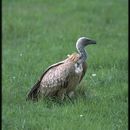Biology
(
الإنجليزية
)
المقدمة من Arkive
As a scavenger, the Cape vulture feeds mainly on carrion. They are gregarious birds, nesting and roosting in colonies on cliffs. When searching for food they form a foraging net across the sky, watching each other as they search large areas to locate a suitable carcass (5) (6). This can require travelling great distances, since the death of animals is unpredictable, (both in timing and location), and farmers in southern Africa often bury carcasses to avoid the spread of disease (6). Many vultures may collect at a carcass, which can lead to an eventful feeding time, with fighting, threat displays and some even inserting their long neck under the skin or crawling into the rib-cage of the dead animal (5).
Cape vulture nests are built in colonies, with up to 1000 breeding pairs building stick platforms lined with grass, on cliff ledges. A single egg is laid between April and July, and both parents take turns with care of the egg and the chick. Fledging occurs after an average of 140 days, and Cape vultures are known to live for over 30 years (7) (8).
Conservation
(
الإنجليزية
)
المقدمة من Arkive
As well as being listed on Appendix II of the Convention on International Trade in Endangered Species (CITES) and Appendix II of the CMS, some breeding colonies of the Cape vulture lie within protected areas (1), such as Marakele National Park in South Africa, which is home to the largest colony (10).
Programmes to raise awareness of the effect of poisons on the Cape vulture have been implemented by government and non-governmental organizations, and the national electricity supplier in South Africa has replaced pylons in some regions with a design that reduces the risk of electrocution to large birds (2). Feeding areas have been established, where food and bone flakes are provided for the Cape vultures and other scavenging birds. These 'vulture restaurants' have been successful in slowing population declines in some areas, increasing the chance of chicks surviving their first year (1), and educating the public about these magnificent and ecologically important birds (6).
However, further conservation efforts are still required to halt the decline of the Cape vulture, and prevent it disappearing from even more of its range.
Description
(
الإنجليزية
)
المقدمة من Arkive
This majestic bird is a member of the Old World vulture family (Accipitridae), and is found only in southern Africa. It has a creamy-buff body plumage, which contrasts with its dark flight and tail feathers and its black bill (2). Adults can be distinguished by their honey-coloured eyes and naked, bluish throat, whilst juveniles have brown eyes and a pink neck (5). When these huge scavengers are flying, the pale, almost silvery, under-side wing feathers can be seen (2).
Habitat
(
الإنجليزية
)
المقدمة من Arkive
Inhabits open grassland, savanna and shrubland (5), and is often found roosting on crags in mountainous regions (1).
Range
(
الإنجليزية
)
المقدمة من Arkive
The Cape vulture is found in South Africa, Lesotho, Botswana and Mozambique. It formerly bred in Swaziland, Zimbabwe and Namibia, but is now extinct in Swaziland, and only small, non-breeding populations persist in Zimbabwe and Namibia (2).
Status
(
الإنجليزية
)
المقدمة من Arkive
Classified as Vulnerable (VU) on the IUCN Red List (1) and listed on Appendix II of CITES (3). It is also listed on Appendix II of the Convention on Migratory Species (CMS or Bonn Convention) (4).
Threats
(
الإنجليزية
)
المقدمة من Arkive
Cape vultures face a number of threats and, as a result, their populations are thought to be declining throughout much of their range (1). A primary reason for these declines is poisoning (9). Farmers sometimes poison carcasses and leave them out to kill unwanted predators, such as leopards and jackals, but often the poison kills large groups of Cape vultures and other scavenging species that also feed on the carcass (5).
A decrease in carnivores within the vulture's range, due to farming activities, has also been blamed for causing skeleton abnormalities in chicks. Large carnivores would break up the bones of carcasses into small fragments, and the Cape vultures would feed these tiny fragments to the chicks as a source of calcium (5).
Collisions with power lines and vehicles are more recent dangers for the Cape vulture, as well as hunting for traditional medicine, human disturbance, and drowning in water tanks (1). In Namibia, mismanagement of rangelands has led to severe bush encroachment over large areas, and recent research has indicated that this has an adverse effect on their ability to find food (6).

